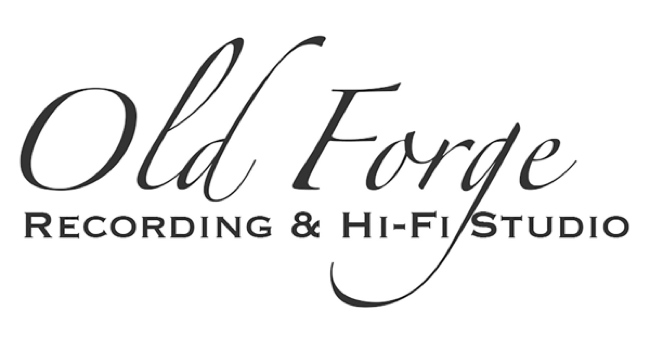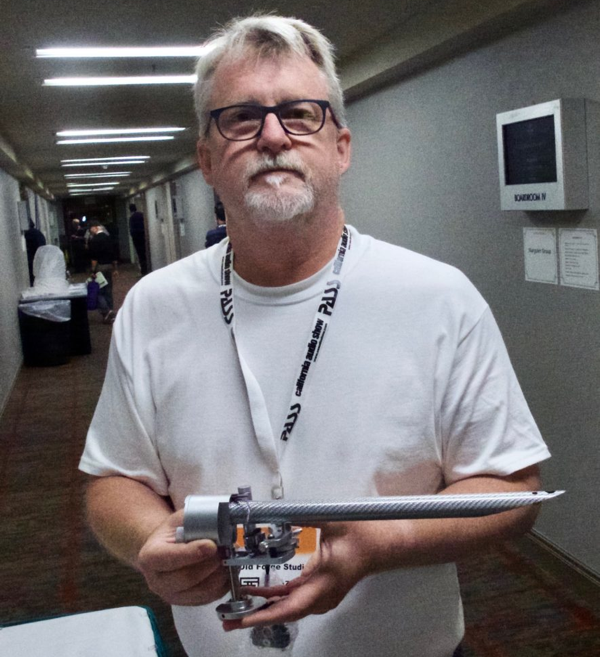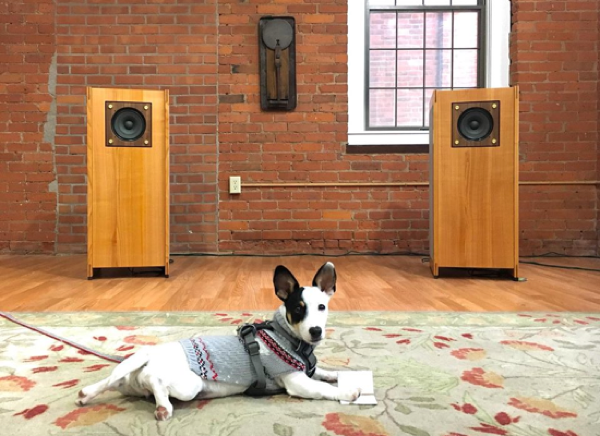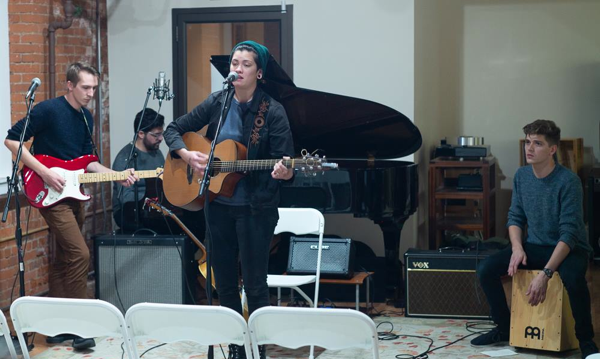
Note: This is the first of what we hope will be many posts introducing audio dealers around the country. We’ve lived in small-town America where to see and hear audio gear required a significant drive, hence the name for this series. We invite you to send us information on dealers you think are worth the drive, and you may see them profiled on our site.
Over the years, Jack has gotten to know David Cope through the Audio Asylum (where they both belong) and in person at audio shows when David was the Audio Note UK representative. They both love SET amplifiers, high-efficiency speakers and well-recorded eclectic music. In fact, Jack has several LPs that he would not have if he hadn’t first heard them in one of David’s rooms at an audio show.
I first heard of David at the Rocky Mountain Audio Show through our friend, Mark Sosa, of Well Pleased Audio Vida. Here’s how this went. Mark asked if we knew the guy who can’t decide whether he owns an audio store or a recording studio. Jack laughed and said you must be talking about David Cope. My first thought was this sounds like there’s a story there, and we have to find out more.

The first step was to walk into the Old Forge Studio room at AXPONA last year and take a look around. It was immediately obvious why David jokes that he is the “king of the kiwis” as he’s the U.S. distributor for the Wand carbon fiber unipivot tonearms and the Wand 14-4 turntable as well as for Pure Audio electronics, all imported from New Zealand. He also swings European with Innuos and Aqua for those customers who prefer digital. Trust us though, as we found out, if all you know about David are his product lines, you are missing a big piece of his story.A
Audio Background
David says his path to working in audio was more sideways than straightforward. After some life and career changes a few years ago, he began to listen to his personal audio system with more interest and decided to stage head-to-head comparisons of the gear in his system with products he wanted to hear. Thanks to Audiogon, he bought products he’d “always been curious about” and compared them to what he had. He kept the products he liked best and resold the ones that came in second-place. Before he knew it, he had built a complete Audio Note system.
Since Peter Qvortrop, owner of Audio Note, was on a forum David subscribed to, David sent him a private message about his shoot-out experience. Peter replied, “Ahh, you’re one of the ones who gets it.” This email led to some face-to-face meetings and eventually to partnering to open an Audio Note store in Glastonbury, CT and to David eventually becoming the Audio Note importer/distributor in the US.
Getting into Recording
During his time with Audio Note, he got first-hand exposure to making an album as a member of the team that recorded Audio Note Music’s Pure Cello project. Some of you may remember the Canadian cellist, Vincent Bélanger, who was the official ‘music ambassador’ for Audio Note Music and traveled around to shows playing his cello and selling his album. There’s a good article on Dagogo that tells more if you are interested.
Working on the Audio Note Music project, renewed his interest in recording and having his own recording studio. In fact, his first attempt at recording was in 2006 when a choir he was in went to Vienna, Austria to participate in a Mozart Festival.
“You have people who work like dogs to get a program down, and then they perform it for a few people once. If you’re in the choir, you don’t really hear it because all you can really hear is the person behind you and the person to your left and the person to your right. And then it’s over. That’s not very satisfying.” At that time of the festival, the recording gear he had included a couple of recording microphones, his laptop and a recording interface, and he stuffed it all in a backpack.
Setting Up a Recording Studio/Retail Store
Shortly after the Pure Cello album came out, David left Audio Note due to some health issues and decided to set up his own small recording studio. Since he still had a penchant for trying out audio gear he was curious about, it wasn’t long before he realized that he had so much stuff in the studio that there wasn’t room for recording. So, he set about finding a larger space that could accommodate both a studio and retail, which is his current location in Mystic, CT. Yes, that’s the town with the river and a 2003 movie directed by Clint Eastwood starring Sean Penn and Marcia Gae Harden.

With “brick and mortar” audio stores almost gone, we were curious about what it was like to run a retail audio store in a tourist town. “I really don’t need 1,000 summertime tourists a day wandering through having no idea what they are coming into. I’m really only doing things that float my boat,” David says. So, his store is located about half a mile from the Mystic River and away from the heavy foot traffic and higher rent prices.
Along with the gear that he imports, David also carries products from Jonathan Halpern of Tone Imports and from Mark Sosa, of Well Pleased Audio Vida. You can find a complete list of the products he carries here on the Old Forge website.
Recording Talented People
When we talked to him, David said he had spent the last two Sunday afternoons recording a Bluegrass duo. In the course of two four-hour sessions, they did about 45 takes of a dozen different songs, which they now have on a digital recording.
“Performers often want to record but they don’t have the money, and they don’t want to be subjected to recording sessions that are overly complicated and drive up costs,” David explains. When a performer is out playing a gig or trying to secure work and they are asked if they have a CD, they often have to say no. After recording with him, the performer or group has a digital recording that they can hand out or turn into a CD.
Recording Basics
The core of the recording system David uses is a pair of AEA ribbon mics. As he explained to us, AEA was the authorized repair center for RCA for a long time, and when RCA went out of business, AEA had every part for every microphone RCA ever made, so they bought the intellectual rights and updated the microphones. Now, they sell these updated versions. A complete list of the gear in his recording studio is included at the end of this article if you are interested in contacting him about recording
David has a few basic rules he follows when making a recording. He uses a minimum number of microphones in order to retain some natural perspective and sense of space and makes the mixing decisions before hitting the record button, so the end result is a two-track tape. David also records in one take to get recordings that sound like live performances.

“I don’t pretend to know how to master,” David says. With a digital recording, it still needs to be mastered to be released on a CD, but at least the artist has something to hand out. “A lot of the young artists have already developed some skills on the computer, so they’re not really shy about developing their own covers and CDs,” he added.
The recording side of his business is not a money-making venture, and he doesn’t charge for recording. “I just get a real kick out of working with musicians. I really do work hard at getting the best sound possible for talented people,” he says.
Summing Up
By the end of our interview, we decided that David is really a guy who just loves music whether he’s recording it or playing it on a high-end audio system. And maybe this statement sums it all up for him, “All this hi-fi gear is very nice, but if all you have to play on it are mediocre recordings of half-baked, so called music, why bother.” You know, I’d bet most of us agree with him.
If you want to hear some of the finest audio products being made today that are also some of the hardest for most audiophiles and music lovers to get a chance to hear, we highly recommend that you visit David’s room at a high-end audio show or make a trip to Mystic and the Old Forge Studio. This is one dealer who’s definitely worth the drive.
Old Forge Studio Recording Gear List
- 2 Royer R-10 passive ribbon mics
- Mara Machines (MCI) 2 track half inch R2R tape deck
- 2 AEA R84 active ribbon mics
- 2 Microtech Gefell M930 large diaphragm condenser mics
- Shure SM-57 dynamic mic
- DW Fearn VT-2 two channel tube mic pre
- 2 Tree Audio Roots Branch II channel strips (tube mic pre, EQ, compression)
- Tree Audio Roots Stem 8 channel mixer
- BURL Audio B2 Bomber ADC – two channel analog-to-digital converter
- Apogee Ensemble Thunderbolt
- Mac Pro, 1 MacBook Pro
- Tascam DA-3000 Digital Recorder
Note: You can read about other Dealers Worth the Drive. Take a look here! And, be sure to suggest dealers you think should be on our list.

The brands link does need to be updated. It is now
https://oldforgeaudio.com/brands/
Thank you, Paul! I’ve updated the links in the article.